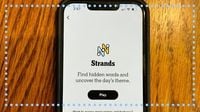On November 15, 2025, puzzle enthusiasts across the globe were greeted with a fresh challenge from The New York Times: the latest edition of Strands, the publication’s increasingly popular daily word-finding puzzle. This particular Saturday’s puzzle, numbered #622, was met with enthusiasm from both seasoned solvers and curious newcomers, thanks to its approachable theme and rewarding gameplay. According to The Economic Times, the day’s puzzle was described as “light and accessible,” with many players noting its suitability for beginners.
But what exactly is NYT Strands, and why is it making waves among word game aficionados? Strands is a digital puzzle that combines the thrill of a word search with the satisfaction of cracking a daily theme. Each day, players are presented with a six-by-eight letter grid—a format that remains consistent across puzzles, as confirmed by both The Economic Times and CNET. The objective is to uncover a set of interlinked words, all tied together by a singular theme. But there’s a twist: nestled within each grid is a special word or phrase called the "Spangram," which stretches across the grid and acts as the conceptual anchor for all the other theme-related terms.
For November 15, the theme was revealed as “We can see right through them.” This cryptic clue, reported by Beebom and echoed by multiple puzzle blogs, immediately pointed solvers toward the realm of sight, optics, and visual aids. The puzzle’s Spangram—a word or phrase that not only links the two ends of the grid but also encapsulates the day’s theme—was the phrase “EYE TO EYE.” Uniquely, this Spangram ran vertically from the top to the bottom of the grid, beginning with “EY,” a detail highlighted by The Economic Times. Solvers who managed to identify this central phrase early on found that it unlocked the rest of the puzzle with relative ease.
So what were the other words hidden within the grid? Consistent with the puzzle’s transparent, vision-related motif, the five theme words were LENSES, GOGGLES, GLASSES, SPECTACLES, and BINOCULARS. These terms, as listed by both The Economic Times and various puzzle hint sites, are all familiar objects associated with seeing more clearly—whether it’s reading a book, swimming underwater, or peering across a field with a pair of binoculars. The puzzle’s structure ensured that every letter in the grid was used, a feature that adds to both the challenge and the satisfaction of completion.
For those new to Strands, the rules are straightforward but engaging. As explained by a daily Strands player in a widely read review, the game is reminiscent of a word search: players connect adjacent letters—horizontally, vertically, or diagonally—to form words that fit the day’s theme. Each puzzle typically contains around seven words, including the Spangram, though the number can vary. Notably, every letter on the board must be used, ensuring that players can’t simply guess their way through without considering the puzzle’s structure.
One of the most appealing aspects of Strands is its hint system. If a player gets stuck, they can earn hints by identifying non-theme words of four or more letters. For every three such words found, a hint is unlocked, highlighting the letters that make up the next answer—though not necessarily showing how they connect. For example, non-theme words like BINS, SEAL, SEES, LEGS, CONS, PECS, TEAS, TALES, and TALE were all valid for earning hints in the November 15 puzzle, as reported by several puzzle blogs. This system encourages exploration and rewards persistence, making the game accessible without sacrificing its challenge.
Despite the clever design and thematic cohesion, the November 15 puzzle was widely regarded as one of the easiest in recent weeks. Both The Economic Times and daily players gave it a difficulty rating of 1 out of 5—the lowest possible score. The clear grouping of theme words and the straightforward nature of the Spangram contributed to this assessment. As one player put it, “I didn’t use any hints for today’s game,” a sentiment echoed by others who breezed through the grid without much trouble.
Of course, not every Strands puzzle is so forgiving. The following day, on November 16, 2025, The New York Times released a much tougher challenge with the theme “Around it goes.” This puzzle, covered in detail by CNET, included a Spangram (“THATSAWRAP”) and hidden words like FOIL, SCARF, SHAWL, STOLE, FLATBREAD, and CELLOPHANE. Many players found the answers difficult to unscramble, and the theme itself was described as “weird” and “tough.” Such variations in difficulty are part of what keeps Strands fresh and engaging for its growing audience.
The appeal of Strands lies not just in its gameplay, but also in its integration into The New York Times’s broader ecosystem of daily puzzles, including Wordle, Connections, and the Mini Crossword. Like these games, Strands resets at midnight, allowing only one play per day—a feature that fosters anticipation and encourages players to return each morning for a new challenge. The game’s popularity has been bolstered by a vibrant online community, where players share hints, compare solving strategies, and celebrate their victories (or commiserate over tough losses).
For those seeking a mental workout or simply a fun way to start the day, Strands offers a unique blend of challenge, discovery, and thematic play. Its daily format, combined with the satisfaction of uncovering interconnected words, has made it a staple for many puzzle fans. And while some days might be tougher than others, there’s always the promise of a new theme and a fresh Spangram waiting just around the corner.
Whether you’re a seasoned solver or a first-time player, Strands continues to prove that the joy of puzzles lies not just in finding the right answers, but in the journey of discovery that unfolds with each new grid.

